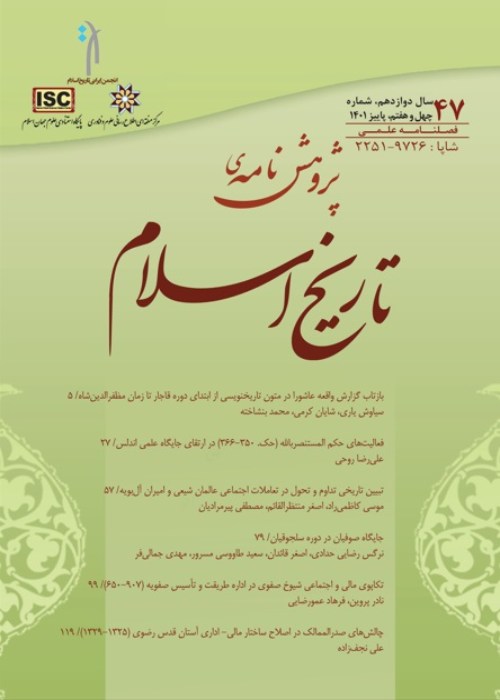The Eeffects of Iranian's Religious Conflicts on Establishment and Empowerment of the IlkhanateGovernancein Iran
Author(s):
Abstract:
The imprudence of Kharazmshahian in interacting with their neighbors and the Caliphate speeded the conquests of the Mongols, and paved the way for their invasion of Iran. However, the existing religious conflicts among Iranians were among the factors which led to stabilization of Mongols government in Iran. Half a century after the establishment of Mongols government in Iran, Hulaguwas given the mission to beseech troops to the west. Doubtlessly, many factors were at work in this historic event. If Iranians were united and if they had aligned themselves with the government, the conquest would have failed or it would have taken the Mongols more time to establish their government and stabilize it. Furthermore, religion played an influential role in unifying various groups of people, sincepolitical government and religion had always been simultaneously in powerin Iran, and political unity depended on religious unity. This article seeks to study the role of religious conflicts in Iran as an important driving force in beseeching Hulagus troops to Iran and continuing his government there. The determined objectives for Hulagus beseeching troops to the west indicate that the Mongols aimed at eradicating Muslims political and religious centers including Ismailis citadels, Abbasid Court and Egypts Mamluks. The downfall of the largest spiritual centers of Muslims and Mongols domination on Iran endangered all Islam. Only during this period, Muslims (both Shiite and Sunni) united to revive Islam. This unity continued by the time Islam became the state religion in Iran again. Having reached their goal, Muslims resumed their conflicts and religious fights over their superiority, despite the attempts made by Gazan to gain support of different sects of Islam and to reconcile them. Continuation of these religious conflicts after the downfall of Ilkhanate government prevented the establishment of a united, integrated and independent government in Iran. Consequently, local governments with various religious approaches began governing different parts of Iran.
Keywords:
Language:
Persian
Published:
Quartely Research Journal of Islamic History, Volume:3 Issue: 10, 2013
Pages:
55 to 77
magiran.com/p1620096
دانلود و مطالعه متن این مقاله با یکی از روشهای زیر امکان پذیر است:
اشتراک شخصی
با عضویت و پرداخت آنلاین حق اشتراک یکساله به مبلغ 1,390,000ريال میتوانید 70 عنوان مطلب دانلود کنید!
اشتراک سازمانی
به کتابخانه دانشگاه یا محل کار خود پیشنهاد کنید تا اشتراک سازمانی این پایگاه را برای دسترسی نامحدود همه کاربران به متن مطالب تهیه نمایند!
توجه!
- حق عضویت دریافتی صرف حمایت از نشریات عضو و نگهداری، تکمیل و توسعه مگیران میشود.
- پرداخت حق اشتراک و دانلود مقالات اجازه بازنشر آن در سایر رسانههای چاپی و دیجیتال را به کاربر نمیدهد.
In order to view content subscription is required
Personal subscription
Subscribe magiran.com for 70 € euros via PayPal and download 70 articles during a year.
Organization subscription
Please contact us to subscribe your university or library for unlimited access!


